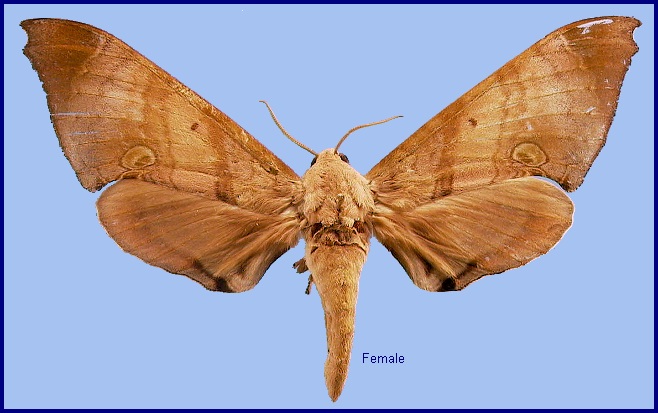
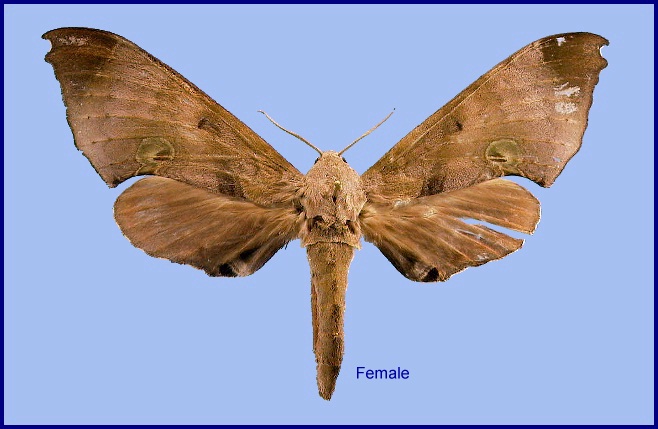
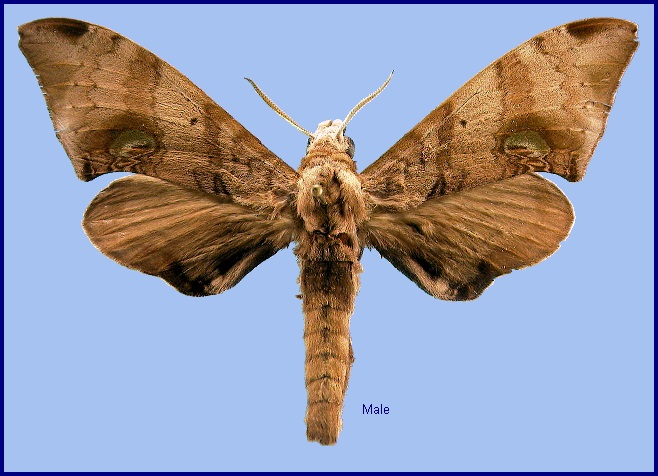
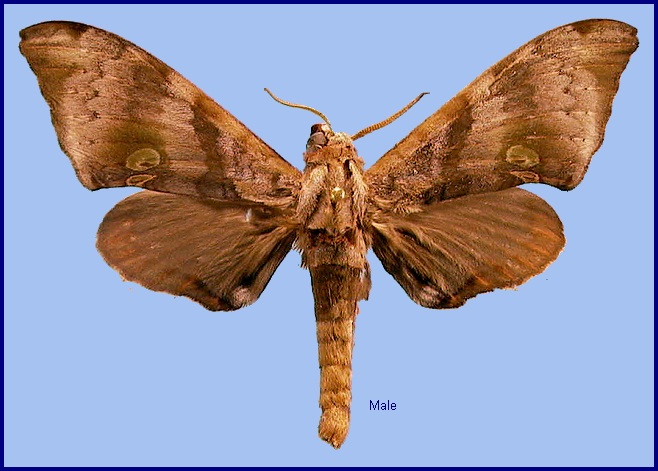
Daphnusa ocellaris Walker, 1856, List Specimens lepid. Insects Colln Br. Mus. 8: 238. Type locality: Borneo.
Synonym. Daphnusa orbifera Walker, 1862.
Synonym. Smerinthus oculata Boisduval, 1875.
Note. Using DNA barcodes, small differences in male genitalia and small variations in wing markings, the taxon originally regarded as Daphnusa ocellaris Walker, 1856, has been split/elevated into seven species (Brechlin, 2009; Haxaire & Melichar, 2009; Melichar & Řezáč, 2014). These are Daphnusa ailanti (Boisduval, 1875), Daphnusa fruhstorferi (Huwe, 1895), Daphnusa haxairei Melichar & Řezáč, 2014, Daphnusa ocellaris Walker, 1856, Daphnusa philippinensis Brechlin, 2009, Daphnusa sinocontinentalis Brechlin, 2009, and Daphnusa zythum Haxaire & Melichar, 2009.
Wingspan: 80--112mm. This species is like a small Marumba, but with a pale patch at the place of the tornal loop on the forewing upperside forming a rather poorly defined ocellus. The male pale reddish-brown or dark olive-brown; collar and vertex of thorax darker. Forewing upperside with two waved subbasal lines angled outwards at 2A+3A, where they join an oblique antemedian band; a crenulate postmedian band bearing a large pale spot at inner margin, the inner side with some red dentate marks; two crenulate submarginal lines; a chestnut patch on costa before apex. Hindwing red-brown, with some bright chestnut lines above anal angle. Forewing underside with two crenulate submarginal lines; hindwing with curved median and postmedian lines (Bell & Scott, 1937).
When Melichar & Řezáč (2014) made comparisons with described and freshly prepared male genitalia, several ambiguities arose regarding interpretation of the morphology. They found that the harpe of Daphnusa ocellaris is consistently curved and hook-shaped, which is in contradiction with the genitalia depicted by Rothschild & Jordan (1903: pl. 32, fig. 16), and reproduced by Bell & Scott (1937: 193). They examined the genitalia of a number of males from both the northern and southern parts of Borneo, but never found genitalia identical to those depicted by Rothschild & Jordan (1903). All the specimens from Borneo that they examined have a hook-like harpe and a pear-shaped juxta. Thus, it is reasonable to consider that the genitalia depicted by Rothschild & Jordan (1903) is erroneous and misleading. Brechlin (2009) presents a more accurate depiction of the genitalia of Daphnusa ocellaris.
The male genitalia are the main feature which distinguish this species from the closely related Daphnusa ailanti. The uncus is strongly bifid; each part consisting of a basal zone and a darkly sclerotised spur, the spur smaller than in D. ailanti, and the basal zone is larger than in D. ailanti. Valve small, rounded, the inner surface concave, with the ventral margin enclosing most of the harpe. Harpe smaller than in D. ailanti and lacking the sharp central flexure of that species. Saccus shorter and broader than in D. ailanti. Phallus bifid with bifurcations twice length of those in D. ailanti.
In the male genitalia, the primary difference between species lies in the morphology of the juxta (Brechlin, 2009). In Daphnusa sinocontinentalis it is finger-shaped, in Daphnusa ocellaris it is pear-shaped, whereas in Daphnusa haxairei it is an elongate V-shape (Melichar & Řezáč, 2014).
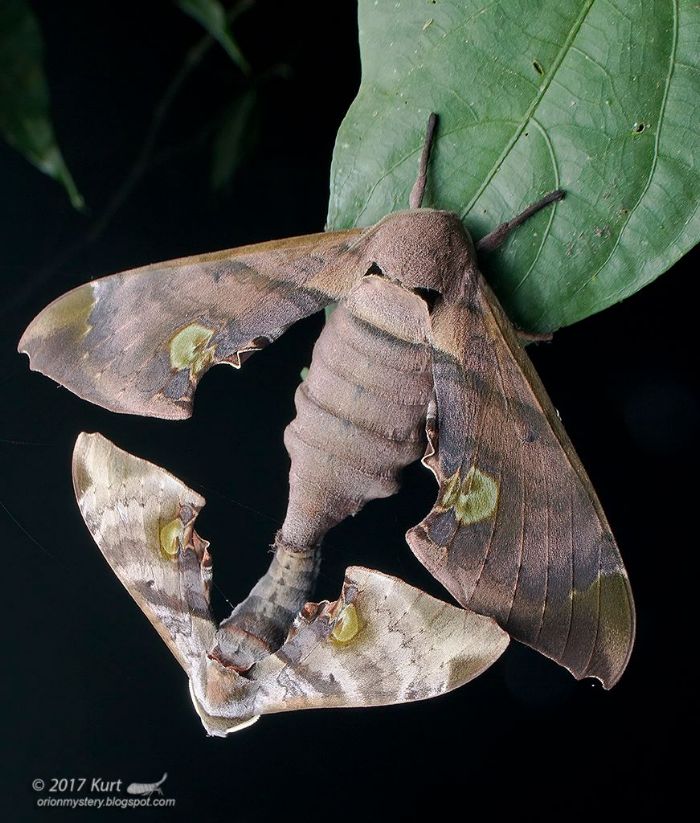
Not recorded.
Taiwan: 16.vii.2004 (Taipei City).
OVUM: Large (2.0-2.2 x 1.8-2.0mm), almost spherical, glossy, pale green when freshly laid, turning pale creamy-yellow with age, often with a pink sheen. Becoming transparent as the larva develops within, with longitudinal purplish body stripes showing through (Gary Saunders, pers. comm. 2025).
LARVA: Freshly hatched larvae are basically yellowish-cream, more brownish dorsally, with a pronounced purplish-brown dorso-lateral stripe along each side. Head tan-brown; horn dark. It settles down to shed its first skin at this stage (often after 1-2 days) before commencing feeding on leaf material (Gary Saunders, pers. comm. 2025).
Fully grown, head large, rounded, thorax and anal segments strongly tuberculate. Horn long, straight, densely tuberculate. Basic body colour green, with a dorso- and a ventro-lateral series of purplish-brown spots in most. Segment 8 almost entirely purple-brown, this belt produced backwards dorsally, forming a large patch on segment 9; there is a large divided dorsal patch on segment 14 (Rothschild & Jordan, 1903).
Feeds high in the crown of trees.
PUPA: Not recorded.
Larval hostplants. Nephelium (Sapindaceae) and Durio (Malvaceae (formally Bombaceae)) (Inoue, Kennett & Kitching, [1996] 1997).
A minor pest of durians (Durio spp.) in Malaysia (Ramasamy, 1980).
[This species will feed on Tilia in captivity (Gary Saunders, pers. comm. 2025). They may also feed on Aesculus and Acer.]
Unknown
Taiwan: Taipei City.
Malaysia (Peninsular; Sarawak; Sabah), Indonesia (Kalimantan), Philippines (Palawan), ?Taiwan (Taipei City), Burma/Myanmar (Tenasserim). Probably also peninsular southern Thailand, but this has yet to be confirmed.
The single Taiwanese record of Daphnusa ocellaris, captured on 16 July 2004 by A. Y. Kawahara, appears to be of an adventive individual. This species is not resident on Taiwan.
Based mainly on barcodes, the tentative ranges of the members of this genus are: Daphnusa ailanti - Indonesia (Sulawesi); Daphnusa fruhstorferi - Indonesia (Sumatra; Java; Bali); Daphnusa haxairei - India (Arunachal Pradesh), Nepal; Daphnusa ocellaris - Malaysia (Peninsular; Sarawak; Sabah), Indonesia (Kalimantan), Philippines (Palawan), ?Taiwan (Taipei City), Burma/Myanmar (Tenasserim); Daphnusa philippinensis - Philippines (Luzon; Leyte; Panay Island); Daphnusa sinocontinentalis - China (Shaanxi; Yunnan; Guizhou; Guangxi; Hainan), Burma/Myanmar (Palaw), Thailand (Chiang Mai; Churt Hubani; Kanchanaburi), Laos (51 km N of Sekong), Vietnam, Cambodia/Kampuchea; Daphnusa zythum - Indonesia (Siberut).
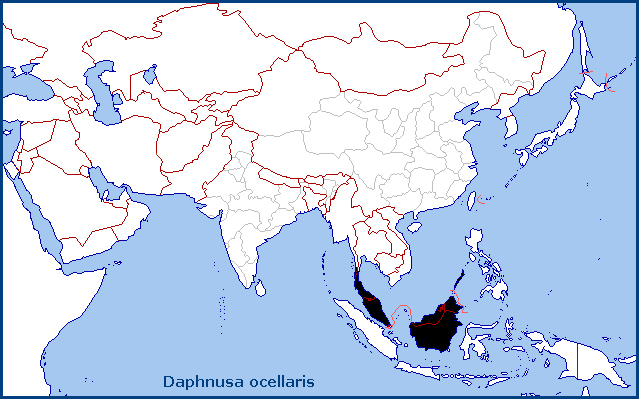
 Return to Sphingidae of the Eastern Palaearctic species list
Return to Sphingidae of the Eastern Palaearctic species list